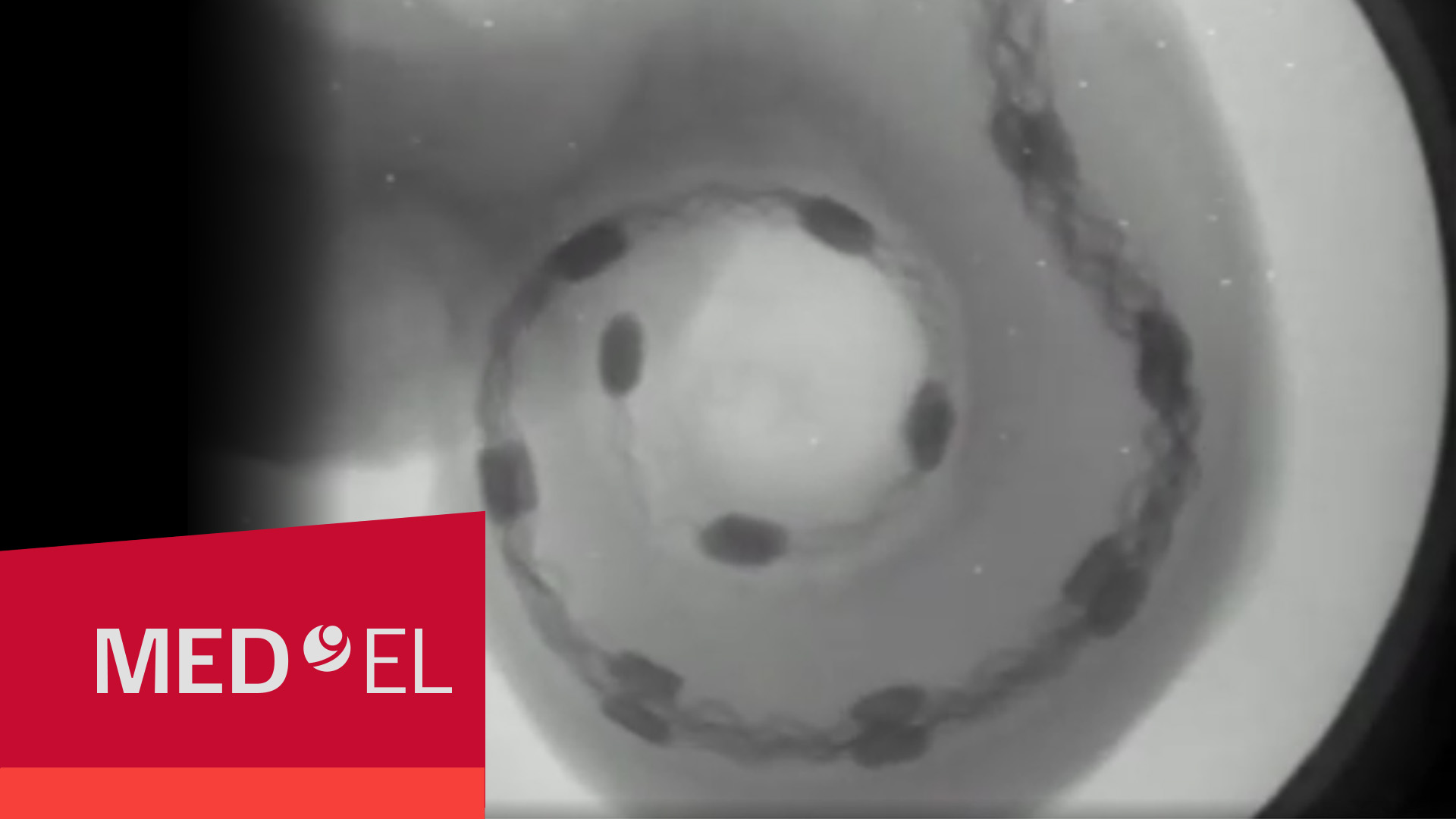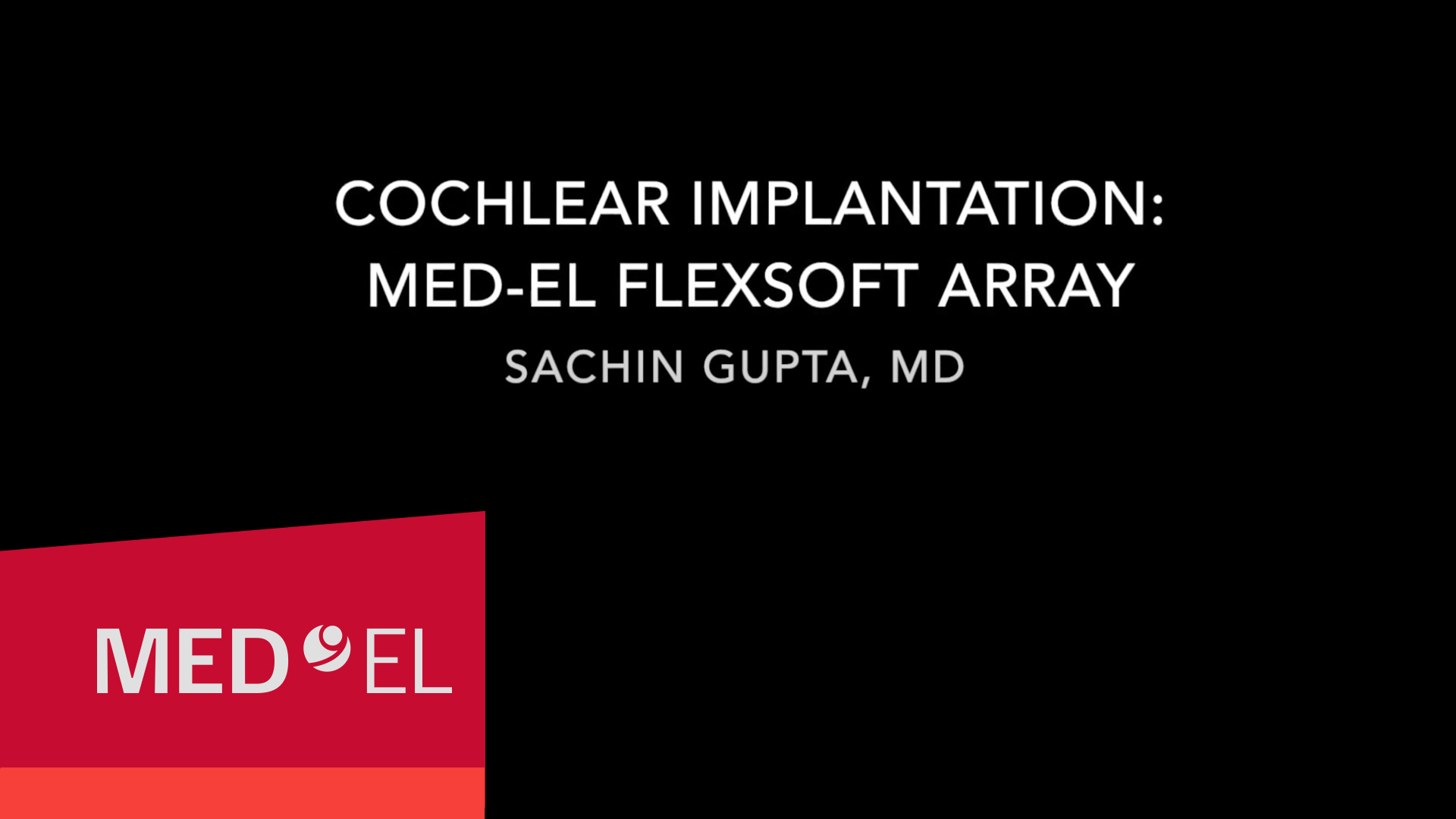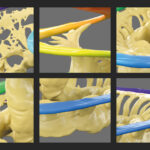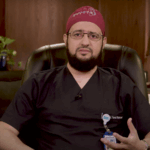MED-EL
Published Sep 09, 2020 | Updated Sep 12, 2024
Surgical Experience With FLEXSOFT Cochlear Implant Electrode Arrays: Dr. Sachin Gupta

In 2020, FLEXSOFT was the longest cochlear implant electrode array available on the market. Today, MED-EL also offers an even longer FLEX34 electrode array. Why do we keep expanding our portfolio and introducing even longer electrode arrays?
The answer is simple. We want to provide electrode arrays long enough to stimulate beyond one and a half turns in terms of angular insertion depth, even in patients with much longer than average cochlear duct lengths. Behind this philosophy is a growing body of research that highlights the benefits of maximizing cochlear coverage and providing a more accurate place-pitch map.Canfarotta, M. W., Dillon, M. T., Buss, E., Pillsbury, H. C., Brown, K. D., & O'Connell, B. P. (2020). Frequency-to-Place Mismatch: Characterizing Variability and the Influence on Speech Perception Outcomes in Cochlear Implant Recipients. Ear and hearing, 41(5), 1349–1361. https://doi.org/10.1097/AUD.0000000000000864[1]Li, H., Schart-Moren, N., Rohani, S. A., Ladak, H. M., Rask-Andersen, H., & Agrawal, S. (2020). Synchrotron radiation-based reconstruction of the human spiral ganglion: implications for cochlear implantation. Ear and hearing, 41(1), 173-181.[2]Erixon, E., Högstorp, H., Wadin, K., & Rask-Andersen, H. (2009). Variational anatomy of the human cochlea: implications for cochlear implantation. Otology & Neurotology, 30(1), 14-22.[3]Büchner, A., Illg, A., Majdani, O., & Lenarz, T. (2017). Investigation of the effect of cochlear implant electrode length on speech comprehension in quiet and noise compared with the results with users of electro-acoustic-stimulation, a retrospective analysis. PloS one, 12(5), e0174900.[4]Buchman, C. A., Dillon, M. T., King, E. R., Adunka, M. C., Adunka, O. F., & Pillsbury, H. C. (2014). Influence of cochlear implant insertion depth on performance: a prospective randomized trial. Otology & Neurotology, 35(10), 1773-1779.[5]Roy, A. T., Penninger, R. T., Pearl, M. S., Wuerfel, W., Jiradejvong, P., Carver, C., ... & Limb, C. J. (2016). Deeper cochlear implant electrode insertion angle improves detection of musical sound quality deterioration related to bass frequency removal. Otology & Neurotology, 37(2), 146-151.[6]
As with all of our FLEX electrodes, FLEXSOFT incorporates our atraumatic FLEXtip technology to help better preserve delicate cochlear structures. In fact, research shows the scala tympani can accommodate our FLEX Series electrode arrays up to two full turns of angular insertion depth, even in the smallest cochleae.
Without further ado, we’re excited to share first-hand experience from Dr. Sachin Gupta from OHSU. He gives us insight into why reducing place-pitch mismatch can be a benefit for patients and why electrode choice has an impact beyond surgery. Dr. Gupta guides us through his surgical technique for handling FLEXSOFT and achieving complete cochlear coverage and atraumatic scala tympani placement.
Let’s turn over to Dr. Gupta for his perspective on using FLEXSOFT.
FLEXSOFT: Surgical Experience
I practice in Portland, Oregon at Oregon Health & Science University (OHSU), in the Division of Otology & Neurotology. I am board certified in both otolaryngology and neurotology. I completed my residency in Otolaryngology at New York University School of Medicine, where I trained under several neurotologists: Drs. J. Thomas Roland, Jr., Anil Lalwani, Pamela Roehm, and Paul Hammerschlag.
I then completed a 2-year fellowship in Neurotology at the University of Texas Southwestern Medical Center, where I had the privilege of training with Drs. Peter Roland, Brandon Isaacson, and Walter Kutz. After completing training, I was an attending surgeon in Otology/Neurotology at Walter Reed National Military Medical Center in Bethesda, Maryland.
In 2017, I began practicing in Portland, Oregon. At OHSU, we have a high volume cochlear implant center, performing around 180 cochlear implant surgeries per year.
I first gained exposure to MED-EL cochlear implants while in residency at NYU, a high volume cochlear implant center. I gained significant experience with MED-EL cochlear implants during my fellowship at UT Southwestern Medical Center.
Our audiologists are the primary personnel who counsel patients on cochlear implant options. They discuss cochlear coverage, as well as place-pitch mismatch, and how this affects the adaptation process with a cochlear implant. MED-EL does a great job in their patient packets explaining these concepts (e.g. pictures comparing the cochlea to a piano and how the longer array covers and represents more pitches).
The scala tympani can accommodate MED-EL FLEX electrode arrays up to two full turns. Can’t See This Video? Watch it on YouTube.
While for some patients’ cochlear anatomy a modiolar hugging array may have benefits, our audiologists have not found a difference in outcomes between modiolar hugging and lateral wall electrodes of the same insertion angle. They feel that especially with patients who have prior hearing experience, it is more important to minimize place-pitch mismatch.
Our audiologists at OHSU favor FLEXSOFT because as it is a longer electrode, there is a better chance of more complete cochlear coverage with less issues from place-versus-pitch mismatch. We use a longer array for patients with or without residual hearing, as our group and others have found hearing preservation to be possible even with a longer electrode.
With regards to surgical placement, for those starting with MED-EL FLEX arrays, I would suggest starting with a FLEX26 or FLEX28, in order to get the feel of how to handle and fully insert the electrode. With experience, the electrode arrays are manageable.
When I started inserting MED-EL FLEX arrays, I encountered difficulty with buckling of the array and incomplete insertion. The electrode array is quite soft and has unique requirements for smooth insertion. I fixed these problems by exposing the round window as maximally as possible, slowly inserting the electrode array, and being willing to adjust the insertion angle as needed to achieve full insertion.
Having placed many FLEXSOFT arrays, my experience is that I can achieve a smooth insertion through the round window in the vast majority of cases. We have been examining our hearing preservation data with the FLEXSOFT cases, and have found encouraging results, suggesting that the longer array likely has consistent, atraumatic placement in the scala tympani.
Placing FLEXSOFT: Surgical Handling
I perform a standard mastoidectomy and facial recess approach to visualize the cochlea. I like to identify the facial nerve and chorda tympani in order to maximize the space available through the facial recess. I routinely use a round window approach for electrode insertion. I drill away the bone overlying the round window as much as possible in order to see the full circumference of the round window membrane. Bony overhangs obscuring the round window membrane can impede full electrode array insertion.
After the round window is fully exposed, I place the cochlear implant receiver in a subperiosteal pocket. I then open the round window anterior-inferiorly, reflecting the membrane away from the bone. I minimize suctioning of perilymph from the cochlea. I then place steroid solution over the round window to help minimize loss of residual hearing. I place hyaluronic acid gel over the round window to minimize entry of blood products into the cochlea, and loss of cochlear perilymph.
In this short video, Dr. Gupta provides a detailed view of his technique for atraumatic FLEXSOFT insertion through the round window. Can’t See This Video? Watch it on YouTube.
I recommend using the FENTEX forceps to handle the electrode array, as these forceps allows for safe, atraumatic handling of the electrode array. The electrode array is quite soft and mobile. To minimize initial movement of the electrode array, I first place it onto the bone overlying the facial nerve, then slowly start to insert it through the opening in the round window. As I am inserting the electrode array, if I feel any resistance or see any buckling in the array, I slow down the insertion and reorient the electrode insertion angle. This allows me to then proceed with smooth electrode insertion.
Thank you Dr. Gupta!
References
-
[1]
Canfarotta, M. W., Dillon, M. T., Buss, E., Pillsbury, H. C., Brown, K. D., & O’Connell, B. P. (2020). Frequency-to-Place Mismatch: Characterizing Variability and the Influence on Speech Perception Outcomes in Cochlear Implant Recipients. Ear and hearing, 41(5), 1349–1361. https://doi.org/10.1097/AUD.0000000000000864
-
[2]
Li, H., Schart-Moren, N., Rohani, S. A., Ladak, H. M., Rask-Andersen, H., & Agrawal, S. (2020). Synchrotron radiation-based reconstruction of the human spiral ganglion: implications for cochlear implantation. Ear and hearing, 41(1), 173-181.
-
[3]
Erixon, E., Högstorp, H., Wadin, K., & Rask-Andersen, H. (2009). Variational anatomy of the human cochlea: implications for cochlear implantation. Otology & Neurotology, 30(1), 14-22.
-
[4]
Büchner, A., Illg, A., Majdani, O., & Lenarz, T. (2017). Investigation of the effect of cochlear implant electrode length on speech comprehension in quiet and noise compared with the results with users of electro-acoustic-stimulation, a retrospective analysis. PloS one, 12(5), e0174900.
-
[5]
Buchman, C. A., Dillon, M. T., King, E. R., Adunka, M. C., Adunka, O. F., & Pillsbury, H. C. (2014). Influence of cochlear implant insertion depth on performance: a prospective randomized trial. Otology & Neurotology, 35(10), 1773-1779.
-
[6]
Roy, A. T., Penninger, R. T., Pearl, M. S., Wuerfel, W., Jiradejvong, P., Carver, C., … & Limb, C. J. (2016). Deeper cochlear implant electrode insertion angle improves detection of musical sound quality deterioration related to bass frequency removal. Otology & Neurotology, 37(2), 146-151.
References
MED-EL
Was this article helpful?
Thanks for your feedback.
Sign up for newsletter below for more.
Thanks for your feedback.
Please leave your message below.
CTA Form Success Message
Send us a message
Field is required
John Doe
Field is required
name@mail.com
Field is required
What do you think?
The content on this website is for general informational purposes only and should not be taken as medical advice. Please contact your doctor or hearing specialist to learn what type of hearing solution is suitable for your specific needs. Not all products, features, or indications shown are approved in all countries.
MED-EL





